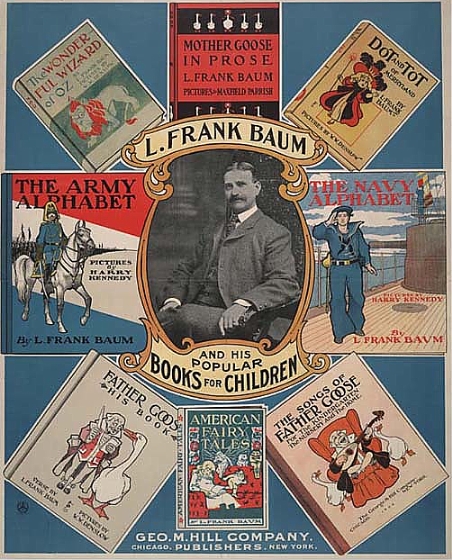L. Frank Baum was born on this date in 1856. He attended the Peekskill Military Academy in Peekskill, NY, when he was 12. There is a small stretch of yellow brick down by the train station that those of use who live in the area like to believe was a particular inspiration to him, in that he was given directions to the school, on first getting off the train, to follow the yellow brick road. This story is, maybe, true. The idea that the word Oz comes from looking at a filing cabinet labeled O-Z may also be true. Maybe not.
What is true is that the book The Wonderful Wizard of Oz, published in 1900, was a big success. Baum followed it with 13 other Oz novels, as well as some Oz-like novels taking place in the surrounding territories, like Ev and Ix, and a warm-hearted biography The Life and Adventures of Santa Claus. But Oz was the big achievement.
You need to know a few things about Oz. It is not, as a certain movie would lead you to believe, an imaginary place, although it did cut itself off from communication with the rest of the world. In the original book, the Kansas part lasts about as long as it takes for the storm to brew, and then, whoosh, we’re not in Kansas anymore. For the first couple of stories, Baum has to transport Dorothy back and forth from Oz to Kansas, but eventually he moves her lock, stock and barrel to Oz permanently, along with her aunt and uncle. Much easier that way. And, of course, those shoes are silver, not ruby. And like the other animals in Oz, Toto can talk: he just usually chooses not to.
The Oz stories are wonderfully whimsical, with characters like the Woggle-Bug and the Patchwork Girl and Jack Pumpkinhead (who looks suspicially like Jack Skellington, if you ask me, but then again, any skinny guy with a round head is going to come out like that one way or the other). They are also filled with strong female characters who get things done, and don’t wait around to be rescued by princes of the charming persuasion. Baum himself had four sons; maybe he just longed for a daughter. Then again, he was a staunch feminist himself, and a strong supporter of women’s suffrage. It shows.
Oz survived Baum. The next set of novels were by Ruth Plumly Thompson, who stuck to the canon while adding some wonderful touches of her own. You can put her books beside Baum’s and give them to any kid just discovering chapter books, and you will have passed along a wonderful world of enchantment and fun (which, needless to say, had its share of librarians banning the books over the years, as they are wont to do, the reason being their lack of literary merit; so much for librarians). Other writers have taken a different tack from the canon, most notably Gregory Maguire’s recent series, begun with Wicked. He's not alone. Science fiction writers like Philip Jose Farmer and Robert A. Heinlein have also had a go at the place, and there are all sorts of television visits and comics and whatnot.
The best Oz remains the original, though. Even the Oz of MGM pales by comparison, even though it may be the most beloved movie ever. The thing about the real Oz is that it is almost endlessly rich, with all those Baum (and later Thompson) books. By the time you read them all, you can just go back and read them again. It’s a whole world, originally imagined by one man.
Baum died on May 6, 1919. Oz shows no sign of dying, ever.
.


No comments:
Post a Comment